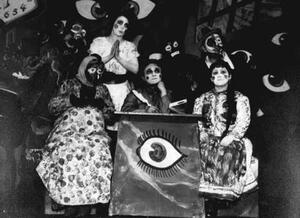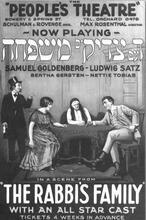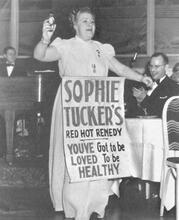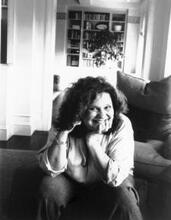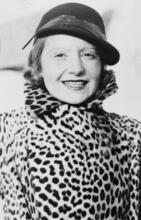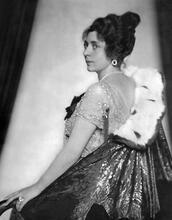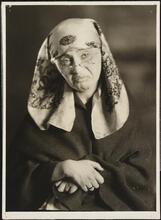Yiddish Theater in Vienna
Jewish theater in Vienna between 1900 and 1938 is inconceivable without women actors. A total of 112 people were active in the Viennese Yiddish theaters, of whom 37 were women. Most of these women originally came from Eastern Europe and learned acting primarily through theater practice. They not only performed in various plays but also met the public’s need for “glitter and glamour,” “stars,” and exoticism. Actors such as Pepi Litmann popularized “trouser roles” in which women depicted men. Female characters were often strongly typified in Yiddish drama, and these female types in Yiddish drama were assigned specifically to individual actresses such as Molly Picon and Mina Deutsch. While women played a significant role in Viennese Yiddish theater, little is known about their lives.
Introduction to Viennese Yiddish theater
Performances in Yiddish were presented in Vienna from 1900 to 1938. From the turn of the century until 1908, folk singers and ensembles from Eastern Europe gave guest performances in meeting halls located in public houses (pubs). The Jüdische Bühne (Jewish Stage), established in 1908, remained in existence until 1938. In the 1920s and 1930s other Yiddish theaters were founded, which often existed for only a few years. Time and again, most of these ensembles consisted of the same actresses and actors, such as Mina Deutsch (Lvov 1887–unknown), who appeared at the Jüdische Bühne before the Freie Jüdische Volksbühne (Free Jewish Popular Stage) was founded. A total of 112 persons were active in the Viennese Yiddish theaters—the Jüdische Bühne, the Freie Jüdische Volksbühne, the Jüdisches Künstlerkabarett (Jewish Artists’ Cabaret), and the Jüdische Künstlerspiele (Jewish Art Theater). Of these, thirty-seven were women. A lack of biographical sources makes it difficult to obtain detailed information about them. They are rarely named in contemporary lexica; in official documents their names are often listed only in conjunction with a husband; articles about their anniversaries are rare; and there is not one self-testimony such as an autobiographical essay or legacy from any woman involved in the Viennese Yiddish theater.
Nevertheless, Jewish theater in Vienna is inconceivable without women actors. Numerous and extensive reviews were published about its female stars, even if they only gave guest performances in Vienna, like the folk singer Pepi Litmann (Tarnopol 1874–1930 Vienna) in the first decade of the twentieth century, or Sevilla Pastor (1905–after World War II, Bucharest) in the 1930s. What may be said in general about women in Yiddish theater is that most of them (like their male colleagues) originally came from Eastern Europe, from Galicia, Romania, and Russia. According to the biographies of Yiddish women actors, such as those that may be found in the Leksikon fun yidishn teater by Zalmen Zylbercweig (1894–1972) and in contemporary newspaper articles, most of the girls and women came to Yiddish theater due to family circumstances. In other words, they were either daughters of a family of actors, like Cilli Bell (born Nowy Sacz, Galicia 1911), Pepi (Perele) Urich (Lvov 1908–Belzec extermination camp 1942) or the daughters of Maurice (1879–?) and Rosa Siegler (Iasi, Romania 1888–Bucharest, after 1945), or they were married to an actor, like Salcia Weinberg (Przemysl, Galicia 1878–Vienna 1940), or to a playwright, like Klara Meisels (née Friedhofer, Lvov 1896–1960 London). Other paths leading to Yiddish theater were choirs (such as the choir of Jacob Ber Gimpel’s Yiddish Theater in Lvov) and amateur ensembles. Only a few female stage artists had professional training in acting. Klara Meisels attended the Max Reinhardt (1873-1943) Acting School in Vienna before she switched to Yiddish theater and a few young women, such as Rahel Weissberg (Sadgora, Bukovina 1901–Belzec extermination camp), were trained at the studio of the Freie Jüdische Volksbühne, which existed for only a brief period. Like their male colleagues, the women learned primarily through theater practice; with enough talent and good direction, they gave outstanding performances. As Jonas Turkow (1898–1988) wrote about Larke Glyksman (Lvov 1885–killed by the Germans): “She was a simple woman, thoroughly traditional, with no higher education—but when one saw her in a serious performance with appropriate direction one was astonished by her profound theater culture.”
As this introduction indicates, women were present in Yiddish theater in Vienna almost exclusively on stage. Only Paula Dreiblatt (Perel Shnayr; Koropets, Ukraine 1895–1938 Vienna) appears to have assumed another position in Yiddish theater when she was temporarily head of the Jüdisches Künstlerkabarett in 1930, but she later returned to her profession as an actor. Direction, administration and management of the Yiddish theater were—with the brief exception of Paula Dreiblatt—entirely the prerogative of men.
Pepi Litmann and “Trouser Roles”
Pepi Litmann was allegedly a cook before her beautiful alto voice made her a popular folk singer, whose husband, the conductor Jacob Litmann, wrote songs and duets for her. In the course of her guest performance tours, Pepi Litmann came to Vienna again and again beginning in 1901, performing at Edelhofer’s Leopoldstädter Volksorpheum together with other so-called “Polish” Jewish actors and singers. Litmann’s voice was described as low and husky. Her repertoire comprised songs from the comic and frivolous to sad, melancholy songs about the lot of the Jews and songs that critically examined current events. All the reviews and reports on Litmann recount the singer’s ability to enthuse and electrify her audience. What was especially fascinating, however, was that Litmann performed in a “trouser role,” wearing the familiar costume of Eastern Jews.
Litmann was undoubtedly one of the first woman to be seen in Yiddish theater in a “trouser role.” Although the appearance of women in the Jewish theater was already taken for granted in Litmann’s time, it was not highly regarded in terms of social standing. Women were forbidden to participate in Purim plays, in which the female characters were played by boys and men. When Abraham Goldfaden (1840–1908) founded his first professional Yiddish ensemble in 1876 in Iasi, Romania, there were still no women on the stage, but this soon changed and a few women performed in Yiddish ensembles as early as 1877. In choosing this profession, these women placed themselves outside the traditional Jewish community, since even in acculturated bourgeois circles the profession of actress was considered disreputable. By the turn of the century, women were already taken for granted in the Yiddish theater, but seeing them in the garb of a hasidic man was still new for the critics. The idea of performing in men’s clothing may have come from non-Jewish female folk singers, such as the so-called “Fiaker-Milli,” who appeared in the 1870s in Vienna in jockey dress, which was considered the “pinnacle of disreputableness” at the time. In Yiddish recital and theater art, Litmann did not remain alone in her preference for performing in hasidic men’s clothing. In his diary for October 5, 1911, Franz Kafka (1883–1924) described a “Jewish society” with a “gentleman imitator.” What contemporary audiences found so fascinating about the “gentleman imitators” may have been its apparent twofold break with tradition—a break that was also an exhibition in the truest sense of the word (exhibited on stage), since no “reputable” woman or girl would show herself on stage in the first place and, secondly, she would not wear men’s clothing. As Eve Sicular writes: “The earlier transformation of the haskole (Enlightenment) movement had already opened the way for secular Jewish literature and theatre, but the idea of women in the public eye as performers was still considered a shande (disgrace) well into the twentieth century.”
Molly Picon
The extent to which Yiddish actresses disregarded this shande with their choice of profession and choice of roles is evident in the extraordinary popularity of trouser roles in Yiddish theater and film. In 1920, at the start of her career, the American-Yiddish actress Molly Picon undertook a major European tour, which also brought her to Vienna. Here, as in other European cities, she became popular in the title role of Yankele, a “yeshive bokher”; in 1922 she shot the film East and West in Vienna, in which she also appeared in one scene as a “bokher.” Picon also appeared in the 1935 film Yidl Mitn Fidl (Yiddle with a Fiddle), here again as Yidl, a boy. Trouser roles were also extremely popular in Jewish theaters in Vienna, where a number of plays depicted girls or women who were first able to succeed in men’s clothing, such as Chantsche in Amerika. There were also dramas in which it became almost a tradition that the roles of young heroes were played by young women, for example the role of Moritz Scharf in Ritualmord in Ungarn (Die Sendung Semaels) by Arnold Zweig (1887–1968). At its 1919 premiere in German in Vienna, the role of Moritz Scharf was played by the then very young and later world-famous actress Elisabeth Bergner. In the 1930s Yiddish production, the role was played by the Yiddish soubrette Jenny Lovic (1912–1965).
Female Actors on the Yiddish Stage
Of course, Yiddish actresses in Vienna did not appear only in trouser roles, since Yiddish theater included the entire Yiddish repertoire from Abraham Goldfaden’s operettas and musical plays and melodramas by Jacob Gordin (1853–1909), to comedies and dramas by Sholem Asch (1880–1957), S. An-Ski (1863–1920), Peretz Hirschbein (1880–1948), and others. In addition, Abisch Meisel wrote a series of Yiddish revues that were very popular in the 1930s. Women and girl characters are often strongly typified in Yiddish drama, their roles essentially comprising the young girl who becomes a victim against her will or because of her naivety or poverty; the willful girl who knows exactly what she wants and gets it; the strong-willed mother who tries to steer family affairs, never giving in to those around her and at times even becoming a real Xanthippe; and the mother who is overwhelmed by modern developments. Unmarried women who take their own affairs and those of their family into their own hands in an independent manner and without male support are an exception, and their independence is usually the result of widowhood.
These female types in Yiddish drama were assigned specifically to individual actresses. For example, as Siegfried Schmitz wrote, Mina Deutsch was a “typical representative of the mother character.” Other stage artists, such as Lea Weintraub-Graf (Botosani, Romania 1888–unknown, presumably murdered by the Germans in Vienna) and Larke Glyksman, were praised for the diversity of their repertoire. Thus Weintraub-Graf was described as having “the rare gift of being able to portray people on stage with simple means, but in such a way that they remained unforgettable.”
In the few articles that were published about Yiddish women actors, their talent and significance in Yiddish theater were emphasized, but at the same time the authors also stressed that the artists did not receive the recognition they deserved in Vienna and that they would have better career opportunities in cities with a larger and more renowned Yiddish theater scene. Since there are no testimonies from the actresses themselves, it is not clear why they remained in Vienna; what is clear, however, is that they (like their male colleagues) frequently gave guest performances abroad. Salcia Weinberg appeared in Budapest and Prague before World War I and participated in a tour through Slovakia in the 1920s. She may have remained in Vienna for family reasons since her husband, Hermann Weinberg, also worked as an actor in Vienna and they had eight children. Larke Glyksman performed in Warsaw, Romania, Czechoslovakia, Belgium, Paris, and London in the 1920s and 1930s, returning to Vienna only in 1936. According to Jonas Turkow, Glyksman was “one of the best Jewish soubrettes in Europe.” She also appeared in Yiddish films such as Yidl Mitn Fidl.
Guest performances in European cities and sometimes also in American cities, in popular spas such as Marienbad and Karlsbad, and in tours through Eastern European countries, were part of Yiddish theater and also influenced the lives of the actresses, who frequently performed in Yiddish theaters in Vienna. Cilli Bell, who debuted in 1922 at the Jüdische Bühne as Yankele, performed as a soubrette in Vienna after 1926. Bela Berson (Blume Zabar; Steblov near Kiev 1886–unknown) came to Vienna in 1905, then went to Chernovtsy; in the years around World War I she was active in Vienna and later in Paris and London, thereafter undertaking guest performance tours in Czechoslovakia and Yugoslavia. Mina Deutsch participated in tours through Romania (with Paul Baratoff) and Galicia. Paula Dreiblatt gave guest performances in Romania, France, and Slovakia. Klara Meisels took part in the guest performance tours of the troupe of her husband Abisch Meisels in the 1930s in Marienbad. After the family’s emigration to London, she performed at the Yiddish theater there. Lea Weintraub-Graf performed from 1909 to 1917 at the Jüdische Bühne in Vienna, with occasional guest performances in Czernowitz, Paris, Galicia, Hungary, and Germany. One of the first actors of the Freie Jüdische Volksbühne in Vienna, she went on to Paris in the fall of 1925 following its demise, returning to Vienna in the early 1930s. Rahel Weissberg attended the drama school of the Freie Jüdische Volksbühne in Vienna, where she appeared together with her husband, the actor Ben-Zion Sigall. She also appeared in the Yiddish theaters of Vienna in the 1920s and 1930s.
These brief descriptions indicate that actors were highly mobile, but apparently spent entire seasons and years performing in Vienna and decisively influencing Vienna’s Yiddish theater. In addition to these women, there were also some who gave only brief guest performances in Vienna, such as Molly Picon (1920, 1922), Clara Young (1921), Henriette Schnitzer (1923), and Betty König (1928). Since these actors, who came mostly from America, fulfilled not only a need for diversity in Yiddish theater, but also an obvious demand on the part of the public and the press for “glitter and glamour,” they were accordingly celebrated as “stars.” Important milestones in the history of Yiddish theater in Vienna were also marked by guest performances by the acting families Nathan and Urich and the Siegler-Pastor troupe. Noemi Nathan (Minsk Mazowiecki, Poland 1891–murdered in Treblinka) came to Vienna in 1920 with her husband, the actor Simon (or Simche) Nathan, performing at the Freie Jüdische Volksbühne. They also gave guest performances in the late 1920s and in 1935, this time with their daughter Ida Nathan, who was also an actor (and like her mother was also murdered in Treblinka). The Urich family, who were also frequent guest performers in Vienna, consisted of Cilli Urich (Lvov 1887–murdered in the Lvov Ghetto 1943), Sami Urich (1882–?) and their daughter Pepi (Perele) Urich. Cilli and her husband Sami appeared during and after World War I at the Jüdische Bühne in Vienna and also at the Jüdisches Künstlerkabarett in the late 1920s. In the 1930s the Pastor-Siegler troupe gave frequent guest performances at the Jüdische Künstlerspiele, with Sevilla Pastor as a celebrated “star.” Rosa Siegler was a singer and actor; she married the actor Maurice Siegler around 1900 and came to Vienna with him in 1909. Until 1915 Maurice Siegler was the director of the Jüdische Bühne, and in the 1920s he and Rosa appeared with the Freie Jüdische Volksbühne. In the 1930s the Siegler family, consisting of Maurice and Rosa Siegler, their daughters Erna Siegler (Vienna 1911–unknown) and Sevilla Pastor, and their son-in-law Muniu Pastor, gave successful guest performances in Vienna. Erna Siegler, who debuted as early as 1920, took part in the troupe’s performances in the 1930s in the role of the romantic lover; after 1938 she fled to the USA. Sevilla Pastor had married the actor Muniu Pastor in 1926; her specialty and greatest success with audiences was in trouser roles.
Conclusion
Women were active in Yiddish theater in Vienna primarily as actors. They not only performed in various plays but also met the public’s need for “glitter and glamour,” for “stars” and exoticism. Trouser roles were especially popular and were presented again and again by the most popular actors. At the same time, the men they portrayed became increasingly distanced from the image of a traditional Jewish man: whereas the first were hasidic boys and youths, such as those brought to the stage by Pepi Litmann from 1901 to 1908, and which Sevilla Pastor also played in the 1930s, Pastor was later also to be seen in male roles, such as that of a locksmith or policeman, that had no connection with traditional Jewish life.
Clearly, the Yiddish actors in Vienna led very active lives. Almost all of them came to Vienna from Eastern Europe and set off from Vienna on numerous guest performance tours. Yet it seems odd that not one of them led her own ensemble (with the exception of Paula Dreiblatt, who briefly directed the Jüdisches Künstlerkabarett together with Max Streng) or worked as a director, manager or playwright. There are only a few indications that in individual cases women also assumed functions of this kind. For instance, Jacob Mestel (1884–1958) mentions that Pepi Litmann, and not her husband, was actually the “baleboste,” in other words the director of their troupe, and he also writes that Pepi Litmann was the first to engage female singers in keeping with the local language demands of the respective performance locations, such as a Hungarian singer in Hungary, etc. Other women presumably also worked on the organization of the troupes, but in a form that is no longer apparent today, since it was never made visible to the outside.
One fact that is particularly conspicuous in the biographies of women in Yiddish theater in Vienna is that they were all married. The only exceptions were young girls who came from acting families and debuted while they were still children—but they also married as soon as they reached a suitable age. Although single and independent women who founded their own ensembles or assumed different roles in various theaters unaccompanied by men were not unusual in the German-speaking theater scene in Vienna, they are not found in the Yiddish theater.
Entrance into Yiddish theater appears to have been gained primarily through family and marriage. There are only a few testimonies of young women choosing the acting profession for themselves. One such was Klara Meisels, who went to Vienna by herself and against the will of her family in 1917. She had trained as a seamstress and with this source of income she began studying medicine. She soon gave up her studies and decided to become an actor. She was accepted into Max Reinhardt’s acting school, where the dramatist and journalist Abisch Meisels saw her in a student performance. After their marriage, Klara Meisels went into Yiddish theater. On the one hand, Klara’s record is typical of the modern era: a young, educated woman with a profession of her own goes to the big city against the will of her family, deciding for herself how to live her life. However, the path to Yiddish theater is the traditional one of marriage.
Unfortunately, Klara Meisels is the only one for whom, thanks to her daughter Ruth Schneider, we have such a detailed and personal account of her background and the reasons for her going into Yiddish theater. For most of the other women, all that is left are only a few reviews and photos showing them in certain roles, and articles in Zylbercweig’s Leksikon fun yidishn teater, in which their periods in Vienna are sometimes not even mentioned.
Women were a strong presence in Yiddish theater in Vienna, as actors and as celebrated and popular stars. However, their reasons for going into Yiddish theater, their exact positions and functions within the ensembles and the theater scene are hardly known and can be reconstructed in only a very rudimentary manner, due to the lack of sources.
(Translated by Alieen Derieg)
Dalinger, Brigitte. “Verloschene Sterne.” Geschichte des jüdischen Theaters in Wien (German). Vienna: 1998.
Ibid. “‘Verloschene Sterne.’ Leben des jüdischen Theaters in Wien” (German). Ph.D. diss., Vienna: 1995.
Holzer, Rudolf. Wiener Volks-Humor. Harfenisten und Volkssänger (German). Vienna: 1943.
Kafka, Franz. Tagebücher 1910–1923 (German). Frankfurt/Main: 1983.
Klanska, Maria. “Emanzipationswege galizischer Jüdinnen im 20. Jahrhundert. Zu den Autobiographien von Ella Schapira, Mischket Liebermann, Helene Deutsch und Salka Viertel.” (German). Von Franzos zu Canetti. Jüdische Autoren aus Österreich. Neue Studien. Tübingen: 1996, 141–162.
Mestel, Jacob. “Pepi Litman” (Yiddish). Leksikon fun yidishn teater, vol. 2, 1054–1057.
Sandrow, Nahma. Vagabond Stars. A World History of Yiddish Theater. New York: 1986.
Schmitz, Siegfried. “Zur Geschichte und zum Problem des jüdischen Theaters in Wien” (German). Jüdisches Leben in Österreich in Wort und Bild, mit Gemeinde- und Vereinskalender für das Jahr 5686. Vienna: 1925, 79–91.
Schneider, Mrs. Ruth. Interview with author. London, June 21, 2002.
Sicular, Eve. “Gender Rebellion in Yiddish Film: Molly Picon, Drag Artiste.” When Joseph Met Molly: A Reader on Yiddish Film, edited by Sylvia Paskin, 245–254. Nottingham: 1999.
Turkow, Jonas. Farloshene shtern (Yiddish). 2 vols. Buenos Aires: 1953.
Zylbercweig, Zalmen. Leksikon fun yidishn teater (Yiddish). 6 vols. New York, Warsaw, Mexico City: 1931, 1934, 1959, 1963, 1967, 1969.

